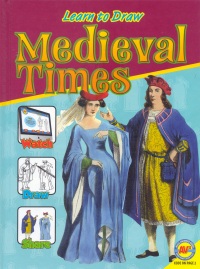| ________________
CM . . .
. Volume XX Number 32. . . .April 18, 2014
excerpt:
Learn to Draw Medieval Times is more than a learn to draw book. It begins with a single page explanation entitled “Why Draw?” The text on this page highlights the connection between drawing, learning and communication. The drawing process “introduces the skills needed to fully express oneself visually.” But each of the step-by-step diagrams is presented following the double-page spread of factual information on one of six medieval times topics. The drawing of the subject then incorporates the learning of the topic and enables the artist to communicate this understanding visually. The people and objects of medieval times have always been fascinating for young readers. Knights, castles, lords and ladies and weaponry lend themselves to visual representation. Learning to draw these objects is fun and, at the same time, focuses the artist on the facts behind the picture. The structure of a castle, the construction and science behind a trebuchet, the symbolism used in a coat of arms, the function of the clothing and armour of a knight become part of the drawing. The one page introduction to medieval times provides a brief overview of the period. The double spread factual information pages provide two paragraphs explaining the various topics: castles, nobility, knights, a coat of arms, a trebuchet and peasants. Unfamiliar vocabulary relevant to the subject is in bold text, and there is a “Key Words” section at the back defining these words. Accompanying the factual information is a large labelled diagram with clear explanations of terms such as a castle’s bailey or the counterweight of a trebuchet. A “Test Your Knowledge” section and a “Draw an Environment” activity are included at the end of the book. Learn to Draw Medieval Times is an AV² media enhanced book by Weigl. This means that, by navigating to the website and using the unique book code printed on page 2, the reader can unlock the multimedia content that supplements the book. Video, audio, weblinks, slide shows, quizzes, activities, and hands-on experiments are included. For classrooms, AV² works with all interactive white boards. With its clear, colourful format, Learn to Draw Medieval Times engages the young reader in an enhanced learning to draw experience. Besides the basic step-by-step diagrams and instructions, the other features of the book, as well as the online content, provide the artist with further drawing and learning activities about medieval times. Highly Recommended. Janice Foster is a retired teacher and teacher librarian in Winnipeg, MB.
To comment
on this title or this review, send mail to cm@umanitoba.ca.
Copyright © the Manitoba Library Association. Reproduction for personal
use is permitted only if this copyright notice is maintained. Any
other reproduction is prohibited without permission.
NEXT REVIEW |
TABLE OF CONTENTS FOR THIS ISSUE
- April 18, 2014.
AUTHORS |
TITLES |
MEDIA REVIEWS |
PROFILES |
BACK ISSUES |
SEARCH |
CMARCHIVE |
HOME |
